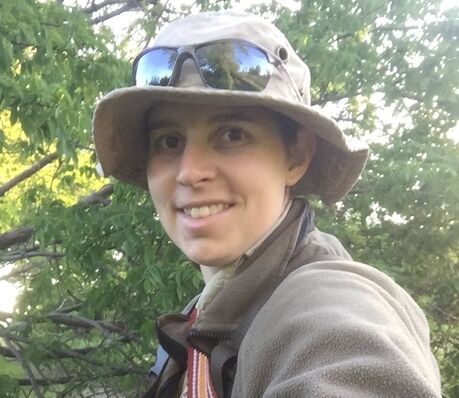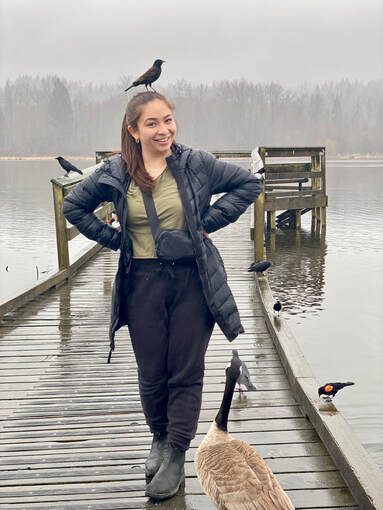Click HERE to learn about our research team's policies and the training environment
Team Leader: Dr. Elizabeth Gow, PhD
I am a Research Scientist at the Pacific Wildlife Research Centre in Delta, BC (Environment and Climate Change Canada) and currently an adjunct professor at the University of Guelph and Simon Fraser University.
Employment Affiliations & Education
Research Scientist, Wildlife Research Division, Science & Technology Branch, Environment and Climate Change Canada
Adjunct Professor, Department of Integrative Biology, University of Guelph
Adjunct Professor, Department of Biological Sciences, Simon Fraser University
Past: Movement Ecologist, Birds Canada
Past: Liber Ero Postdoctoral Fellow, Department of Integrative Biology, University of Guelph
Past: NSERC Postdoctoral Fellow, Department of Integrative Biology, University of Guelph
Past: Killam Postdoctoral Research Fellow, Department of Conservation and Forest Sciences, University of British Columbia
PhD University of Saskatchewan
MSc York University
BSc York University
Contact: egow (at) uoguelph.ca or elizabeth.gow2 (at) ec.gc.ca
Google Scholar Link
Employment Affiliations & Education
Research Scientist, Wildlife Research Division, Science & Technology Branch, Environment and Climate Change Canada
Adjunct Professor, Department of Integrative Biology, University of Guelph
Adjunct Professor, Department of Biological Sciences, Simon Fraser University
Past: Movement Ecologist, Birds Canada
Past: Liber Ero Postdoctoral Fellow, Department of Integrative Biology, University of Guelph
Past: NSERC Postdoctoral Fellow, Department of Integrative Biology, University of Guelph
Past: Killam Postdoctoral Research Fellow, Department of Conservation and Forest Sciences, University of British Columbia
PhD University of Saskatchewan
MSc York University
BSc York University
Contact: egow (at) uoguelph.ca or elizabeth.gow2 (at) ec.gc.ca
Google Scholar Link
Current Graduate Students
Triana Hohn - Master's student
Simon Fraser University, co-supervised with Dr. David Green

I completed my B.Sc. (Honours) in Zoology from the University of Calgary in 2023. For my honours project, I studied post-conflict behaviour of gelada monkeys as part of the Guassa Gelada Research Project with Dr. Vivek Venkataraman. In 2022 I began working as a field technician on Dr. Gow’s urban songbird project with Environment and Climate Change Canada. I am now a M.Sc student at Simon Fraser University, co-supervised by Drs. Elizabeth Gow and David Green. For my M.Sc. Thesis, I am exploring how human activity in urban parks impacts Spotted Towhee behaviour, physiology, and reproduction. My field work involves nest finding and monitoring, banding and collecting biological samples from adult and nestling spotted towhees, and manual radio telemetry to obtain detailed information on adult spotted towhee habitat use. I hope my research will help inform management practices and promote sustainable coexistence between wildlife and humans in urban areas.
Olivia Wilson - Master's student
University of Northern British Columbia, co-supervised with Dr. Erin Baerwald
I received my B.Sc. in Biology from McMaster University in Hamilton Ontario. I am now completing my M.Sc. in Natural Resources and Environmental Studies at the University of Northern BC. My current project uses trail cameras to study the abundance and occupancy of free-roaming domestic cats in the South Okanagan Valley. I have placed trail cameras in urban, peri-urban, protected, and agricultural areas from March to December 2022 to help identify habitats that cats like to associate with and if cats occur in areas with species at risk or areas of high bird abundances. I have also placed trail cameras outside of bat roosts to examine cat behaviour and predation events.
Vanessa Hum - Master's student
Simon Fraser University, co-supervised with Dr. David Green
At the end of 2021, I completed my BSc. in Environmental Science minoring in Biology and Chemistry at Carleton University. During my honours thesis researching volunteering in the environmental sector, I discovered an organization that strives to reduce bird mortality from window collisions, Safe Wings Ottawa. I eventually led a few unique projects that combined both my passions for art and science. I designed and illustrated bird-friendly murals at high risks sites in the Ottawa area. Creating bird-friendly mural allows for science communication and education, while reducing window collisions. These projects led me to my current research for my MSc. at Simon Fraser University. I am evaluating bird collisions with windows at SFU’s Burnaby Campus through year-round collision monitoring, point counts and carcass persistence trials. I hope to evaluate species vulnerability, seasonal variability and determine the variables high-risk facades. I believe my research findings can aid in implementing building policy and solutions to reduce future window collisions.
Jonathan Chu - PhD Student
University of Guelph, co-supervised with Dr. Ryan Norris
I attended the University of Toronto for both my BSc. and MSc where I studied avian movement ecology. I was interested in how flight efficiency affected both migration and dispersal movements, and harnessed community science and museum data to approach these questions. For my PhD I’m excited to explore the role outdoor cats play in urban ecosystems. Understanding the dynamics of native species and non-native species in urban ecosystems is of ecological importance, particularly in the case of outdoor cats as they are an important companion animal. CatCams, animal-borne cameras attached to cats, presents the opportunity to answer some of the open questions regarding outdoor cats while also incorporating the participation of the community. I plan to explore deep learning approaches to automate the processing of footage captured by CatCams, so that ecologically relevant footage can be quickly accessed. With this footage I plan to estimate the predation rates imposed by cats on native wildlife and explore how these predation rates change through habitats. This information will help clarify the role outdoor cats play in urban ecosystems and help inform management strategies so that both wildlife and cats are protected.
Past Students/Affiliates
Marlee Pyott - Master's student
University of Guelph, co-supervised with Dr. Ryan Norris
University of Guelph, co-supervised with Dr. Ryan Norris
I completed my B.Sc. in Zoology at Laurentian University in Sudbury Ontario. Following this, I was accepted to the University of Guelph where I am now studying domestic cats as a part of my M.Sc. research in the Integrative Biology (One Health) program. Domestic cats are one of the most popular pets worldwide, providing companionship for millions of people. However, when it comes to cat care there is a flashpoint of controversy surrounding whether owners should provide their pet with unsupervised outdoor access. While an outdoor lifestyle can be beneficial because cats can get more exercise and are able to engage in a more natural behaviour, there are concerns for their predation on native wildlife, welfare, and pathogen transmission among other cats, people and wildlife. To determine the costs and benefits of providing unsupervised outdoor access will involve understanding the health consequences to both cats and their owners and the impacts cats can have on native biodiversity. For this research, I propose to obtain this critical information by using newly developed animal-borne cameras called Catcams. These lightweight cameras attach to the cat’s collar and can give insight into how cats interact with their environment, by providing a first-person perspective of their world. The results will provide the first estimates of outdoor cat welfare risks and predation rates in Canada, throughout the annual cycle and during both the day and night.
Hannah Clyde - MSc 2020
University of Guelph, co-supervised with Dr. Ryan Norris
Estimating habitat characteristics associated with the abundance of free-roaming domestic cats across the annual cycle
University of Guelph, co-supervised with Dr. Ryan Norris
Estimating habitat characteristics associated with the abundance of free-roaming domestic cats across the annual cycle

I completed my B.Sc. in Honours Biology at McMaster University and my M.Sc. at the University of Guelph. For my M.Sc., I examined how free-roaming cat abundances change seasonally. Free-roaming cats include any domestic cat with unsupervised access to the outdoors (including owned and unowned cats). These animals can have negative impacts on the ecosystem. However, determining the impacts of free-roaming cats on wildlife requires understanding where cats are found and how cat abundances vary across the year. We used trail cameras in rural and urban areas in southern Ontario, Canada, to accomplish this goal. We found that cats were more likely to be found near buildings and away from agriculture in the spring/summer. In the fall/winter, cats were found near major roads and away from coyotes. Our research shows that the development of management strategies aimed at reducing free-roaming cats in temperate areas should incorporate seasonal and landscape patterns.




